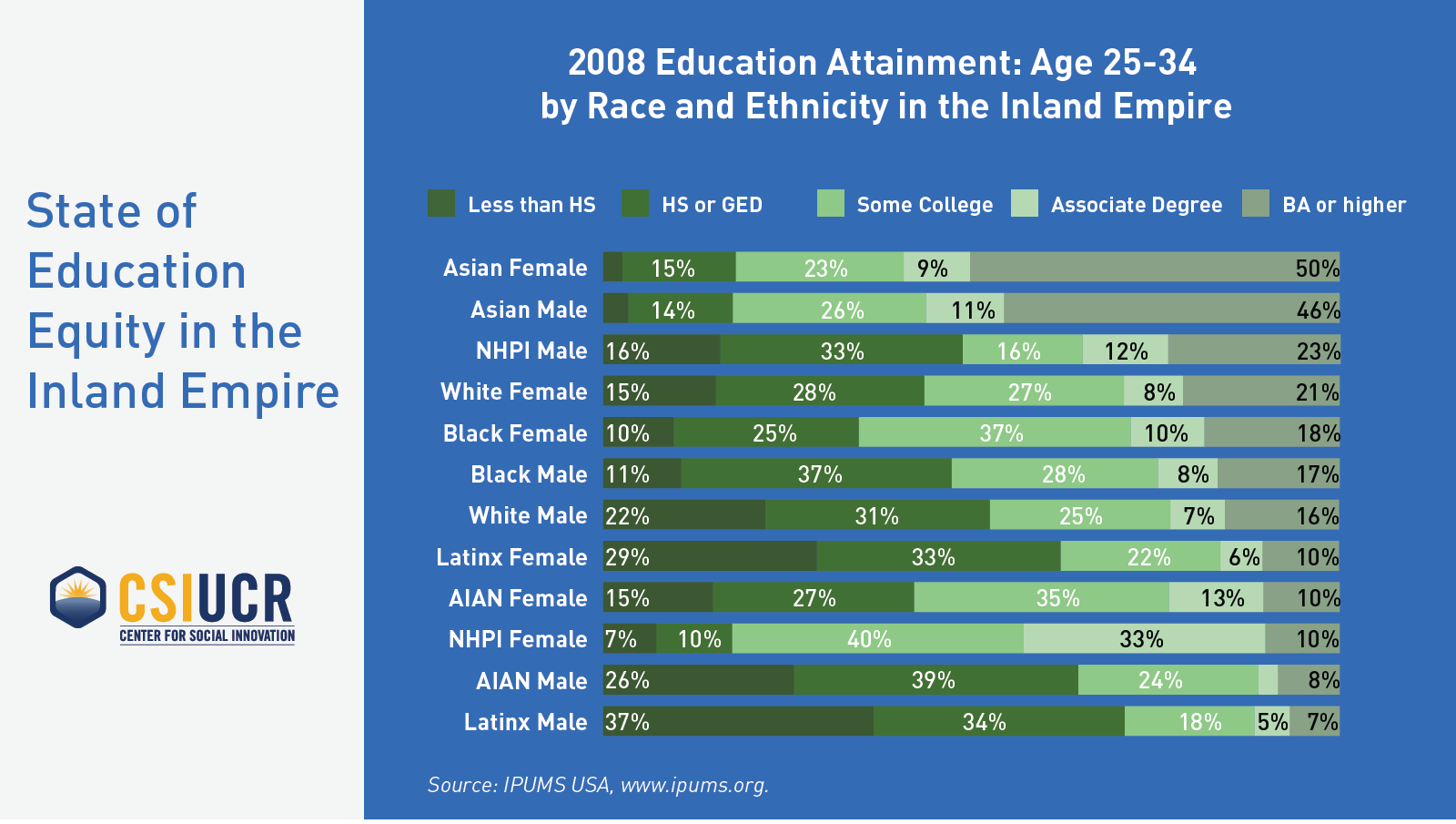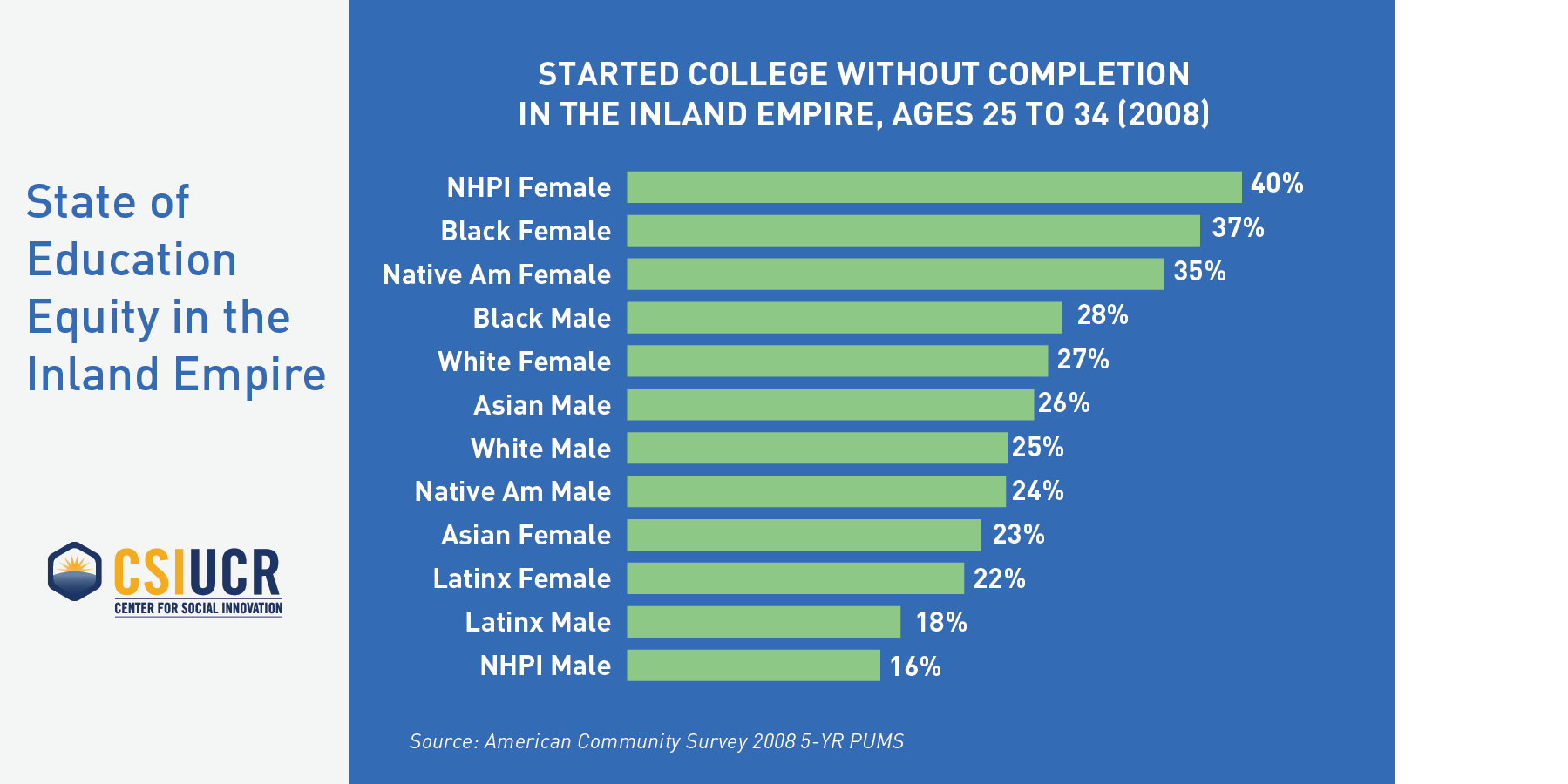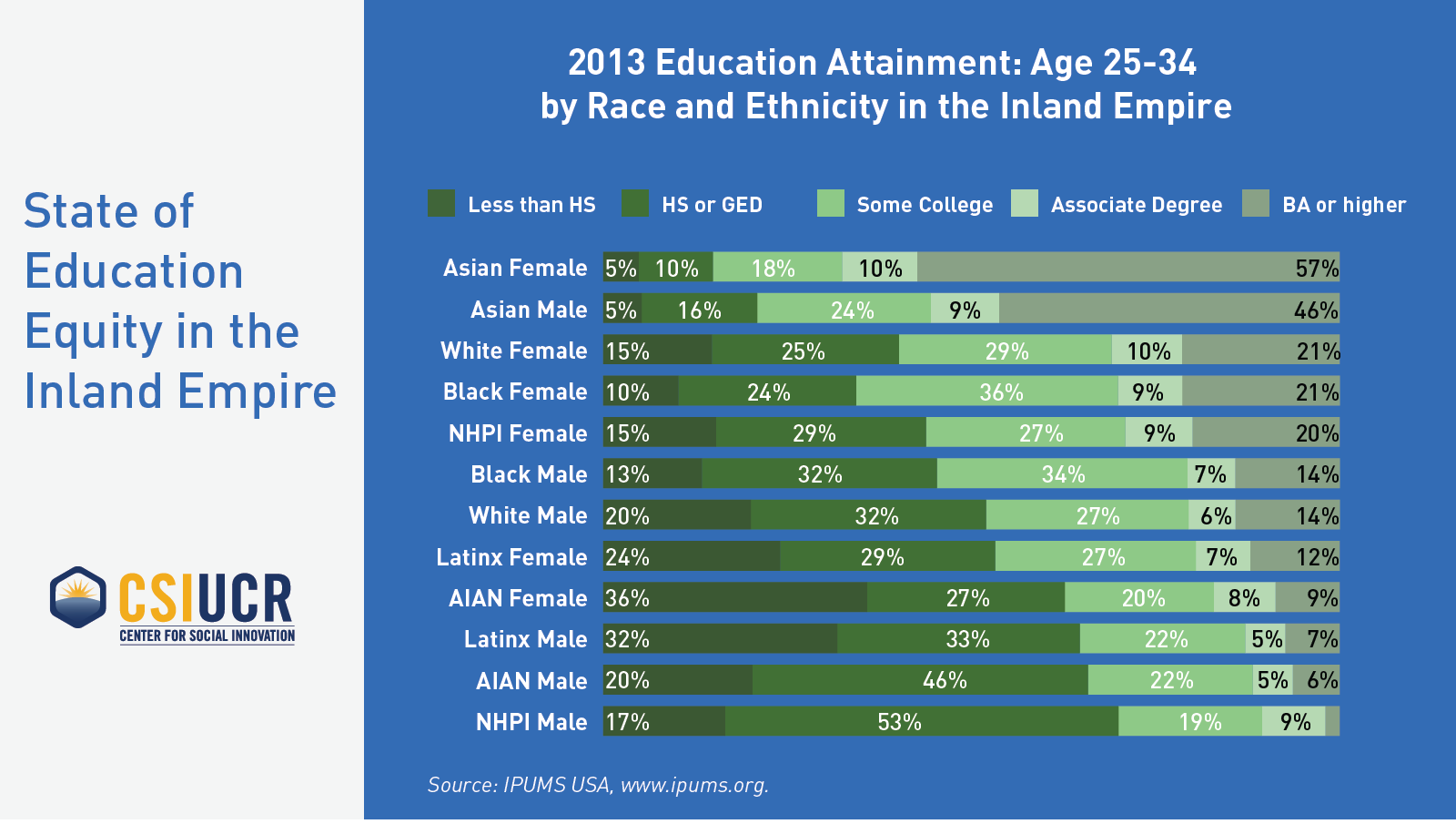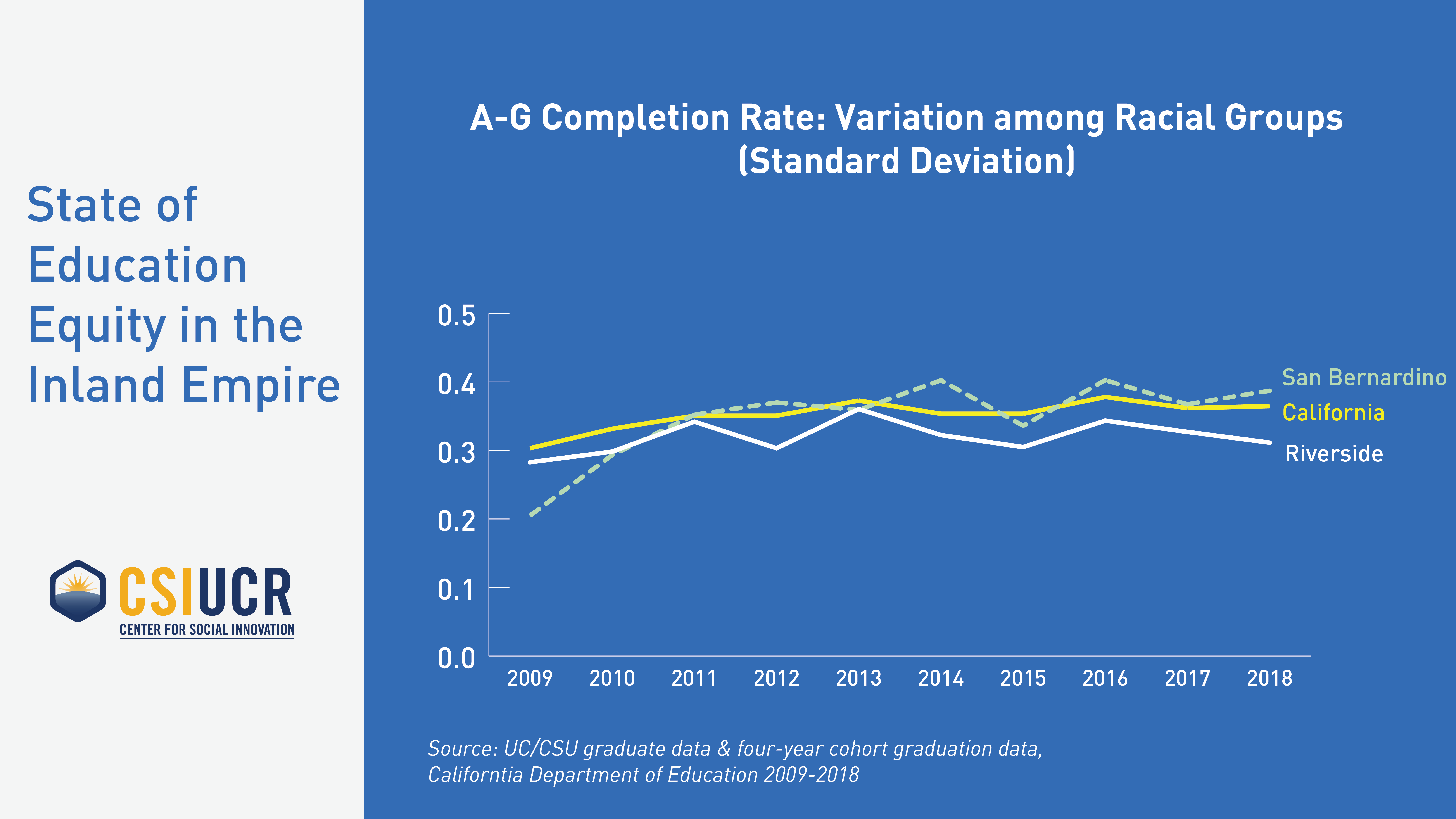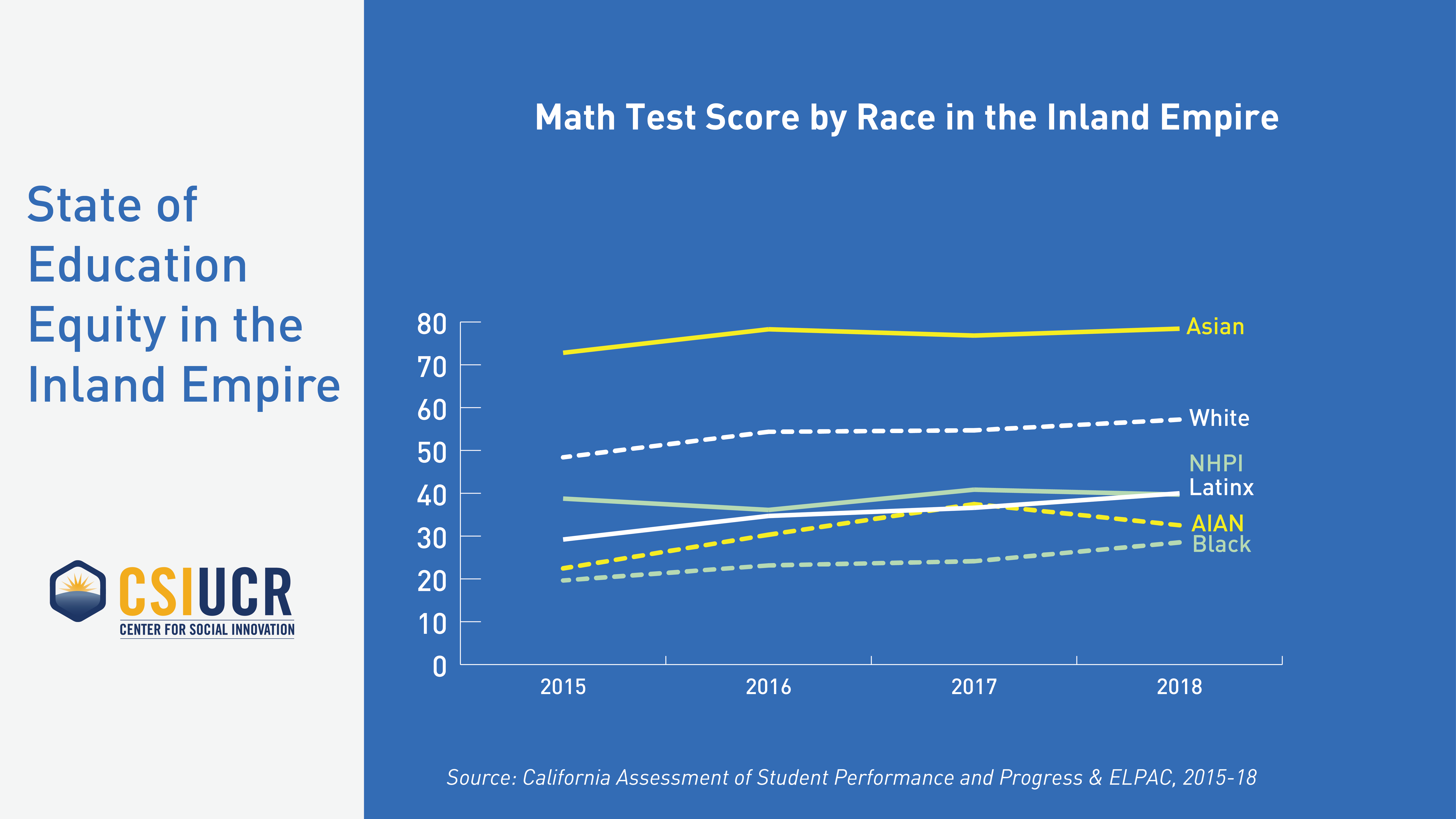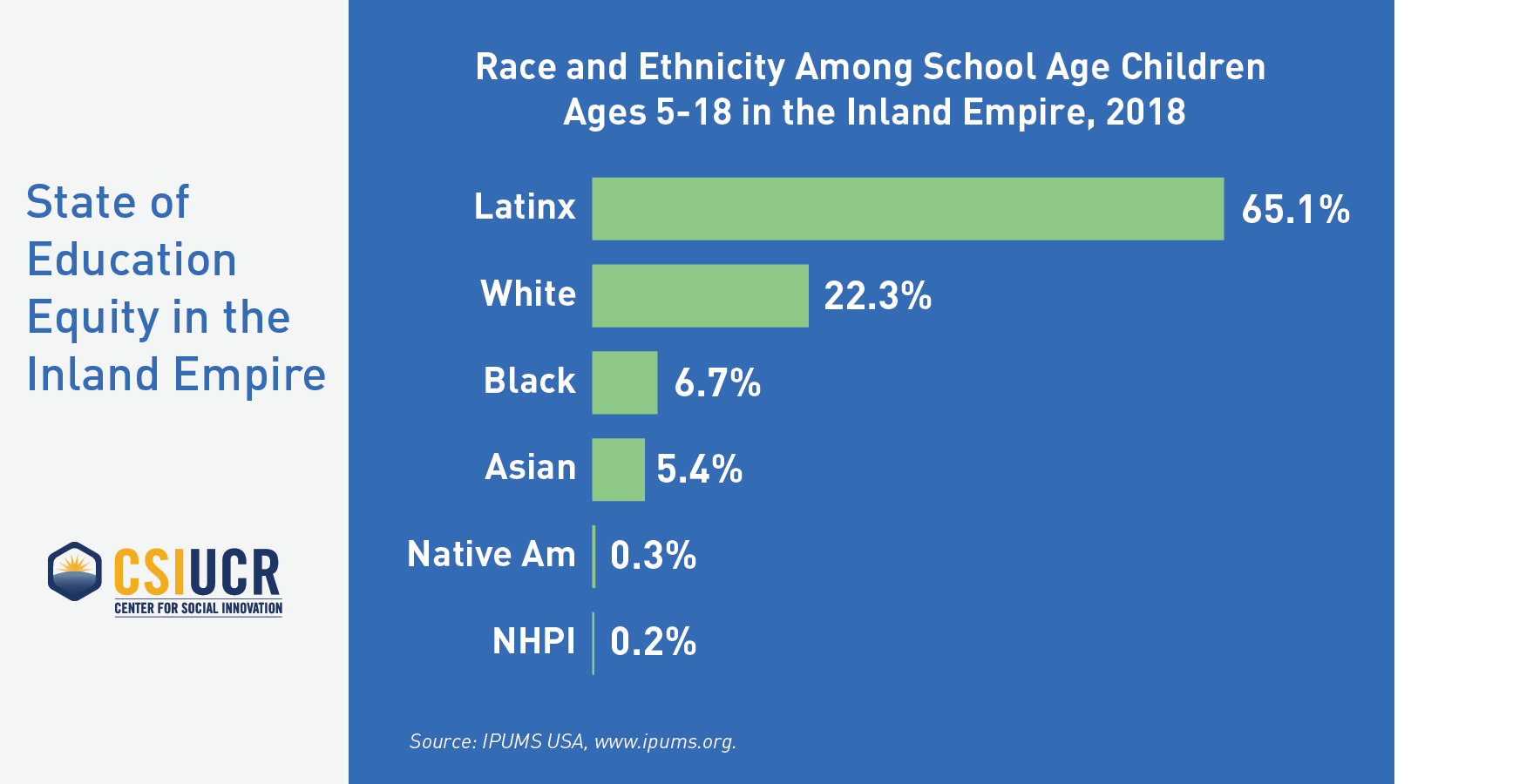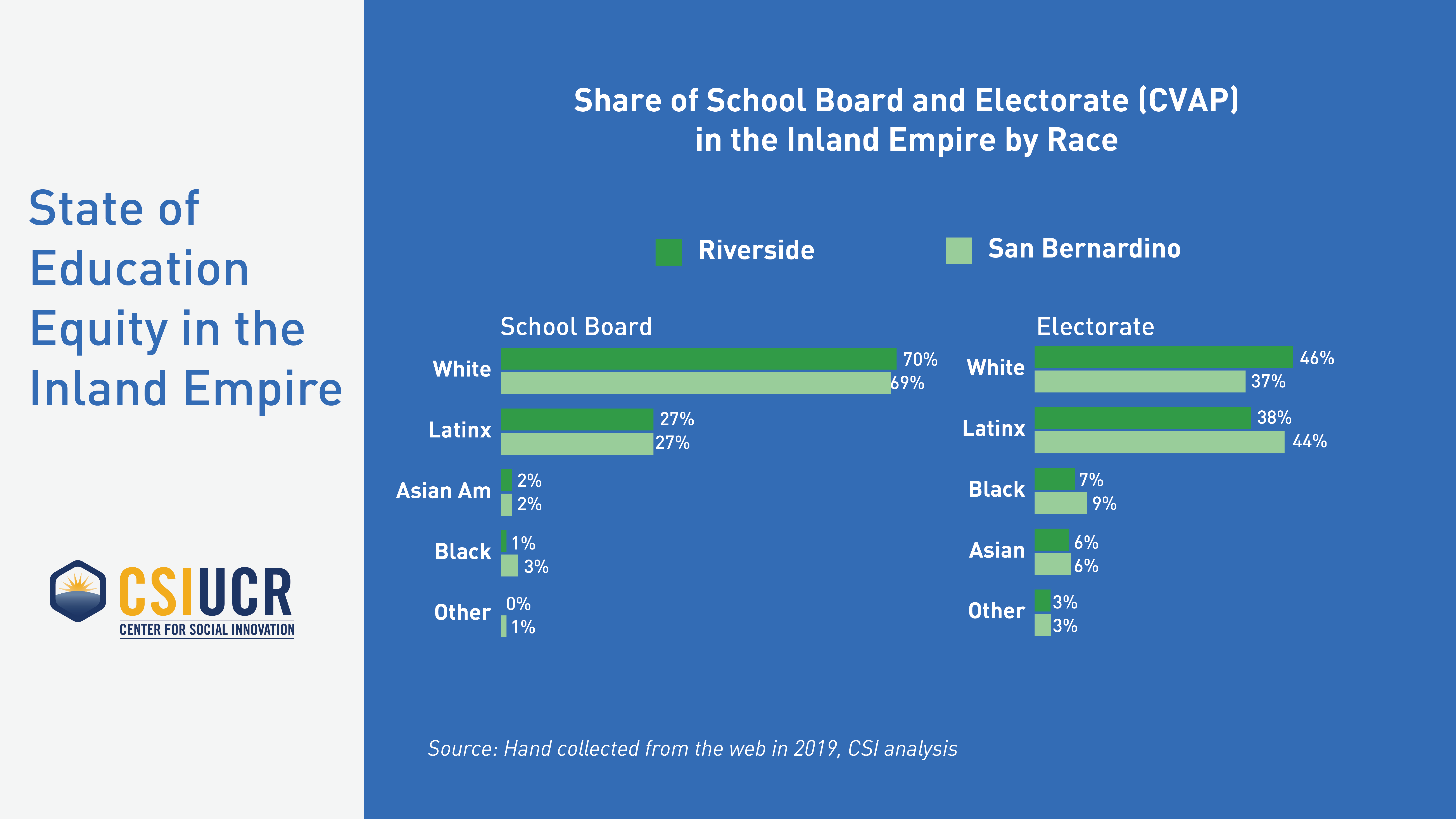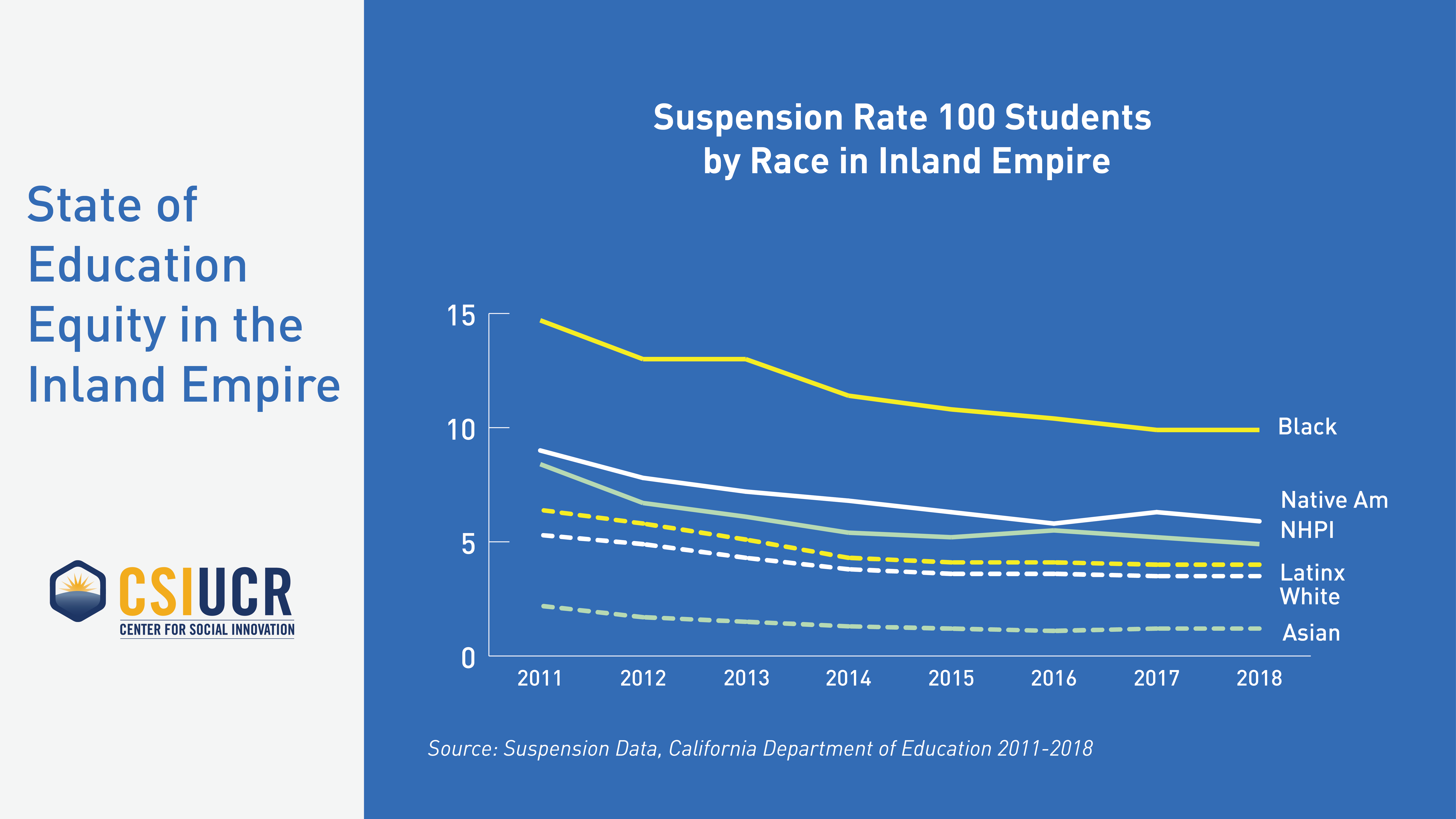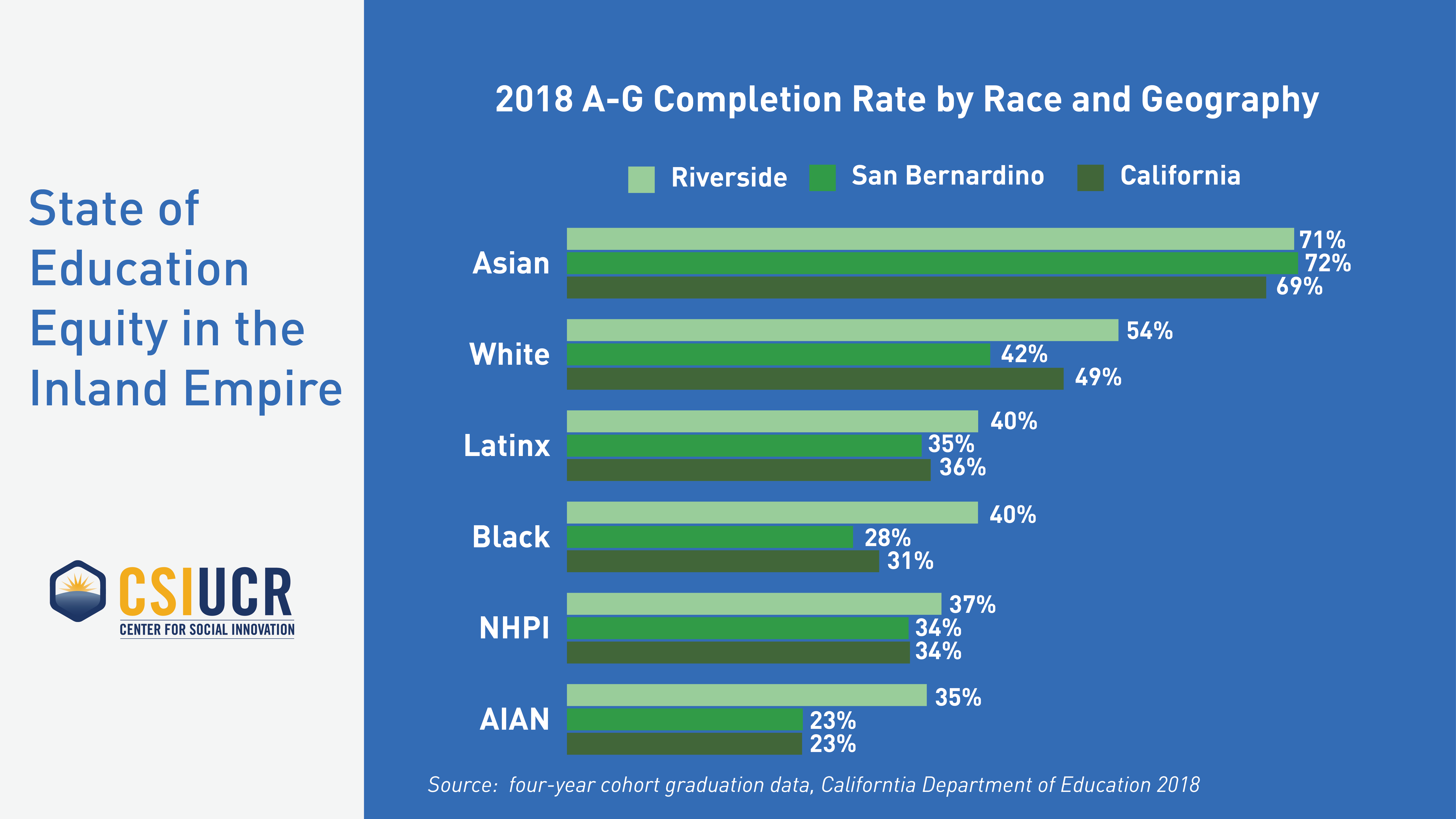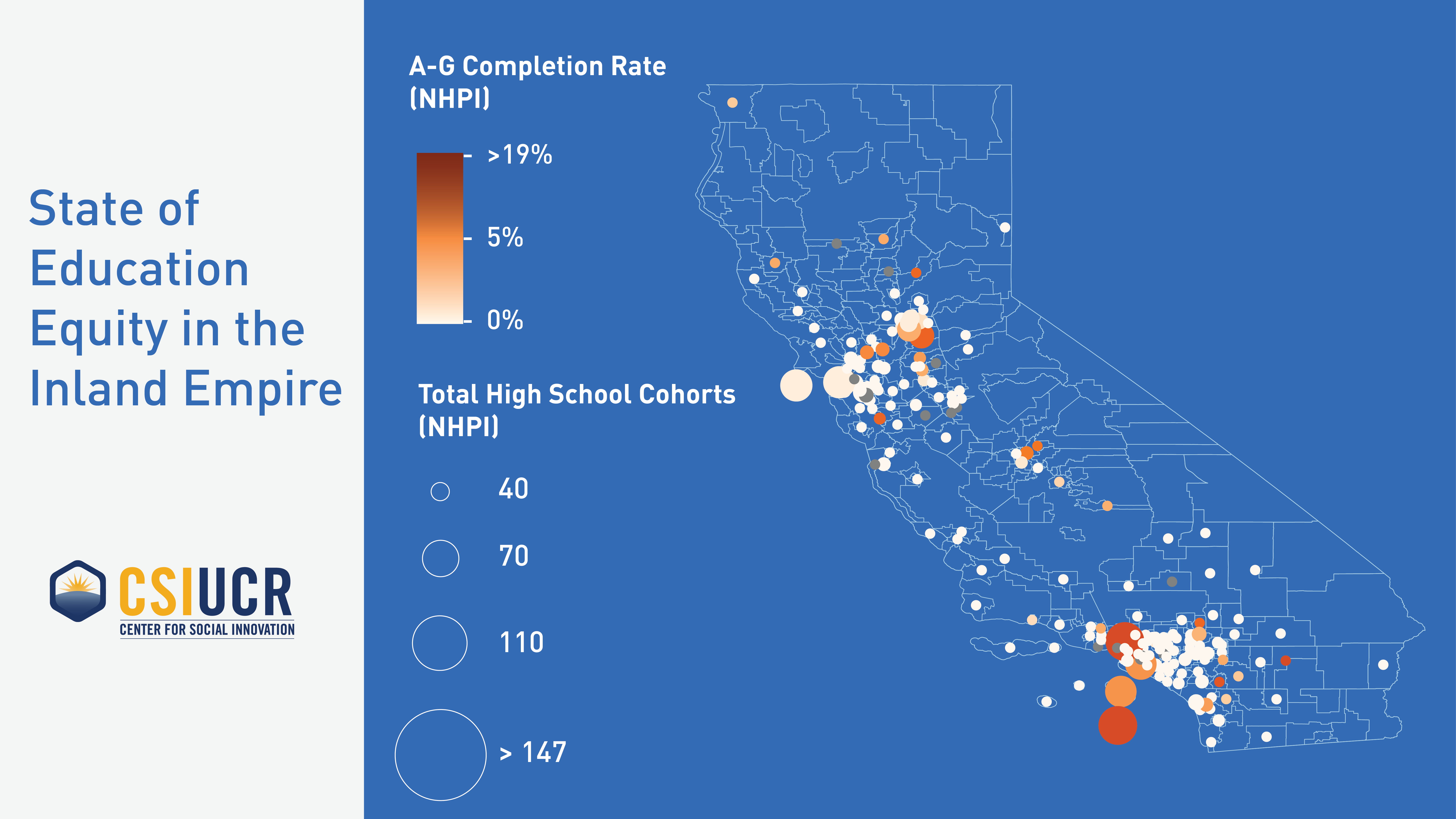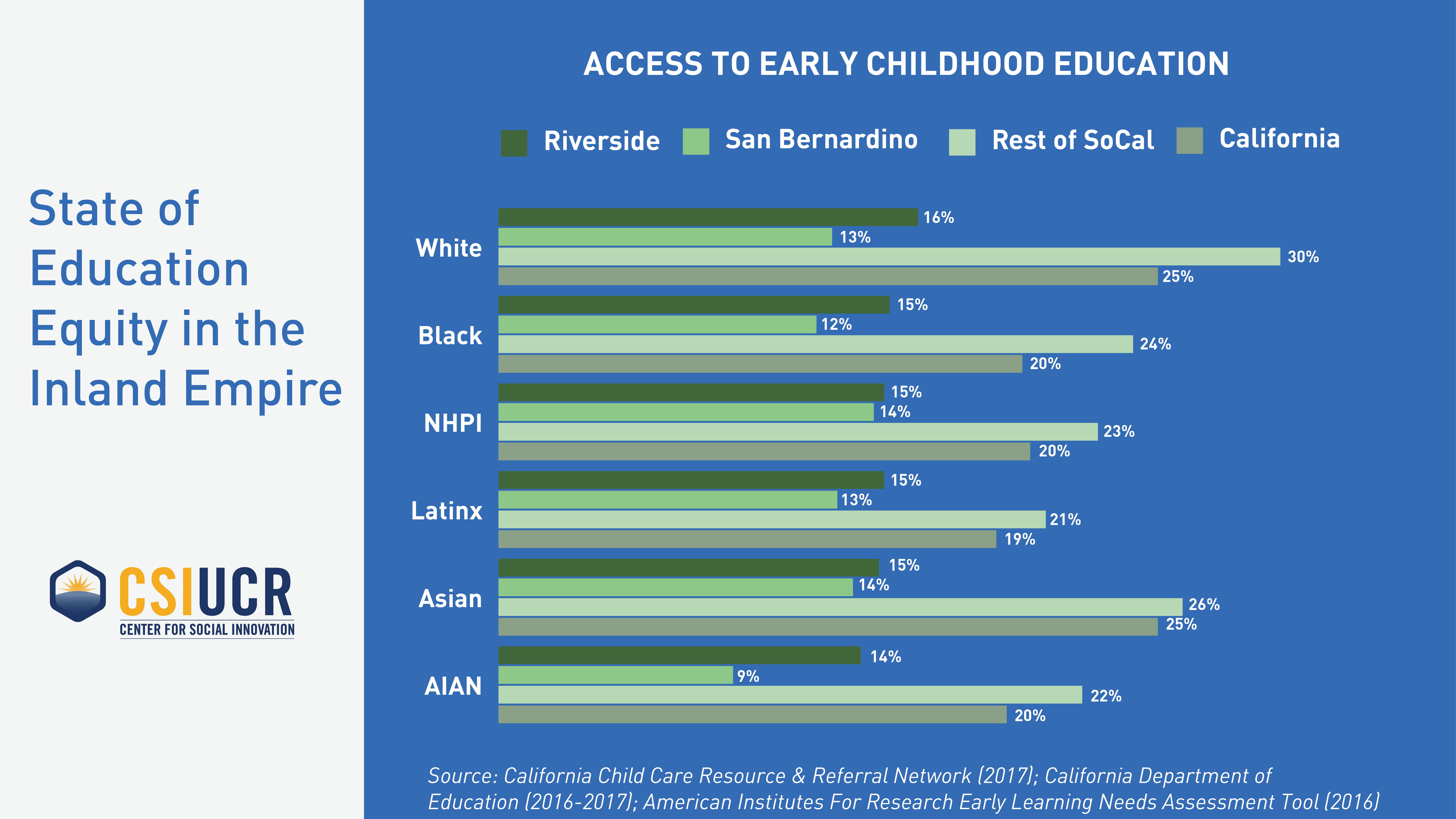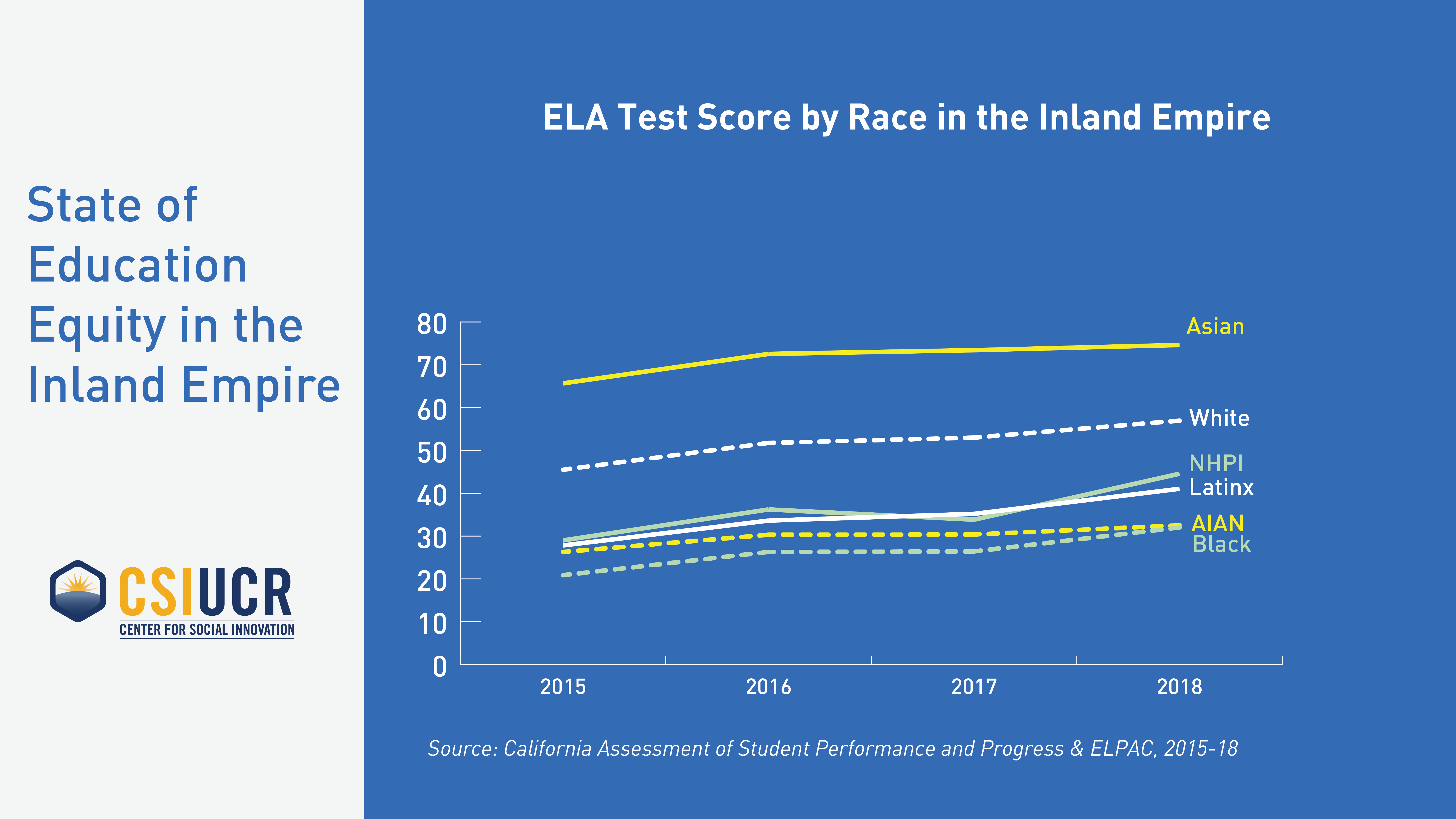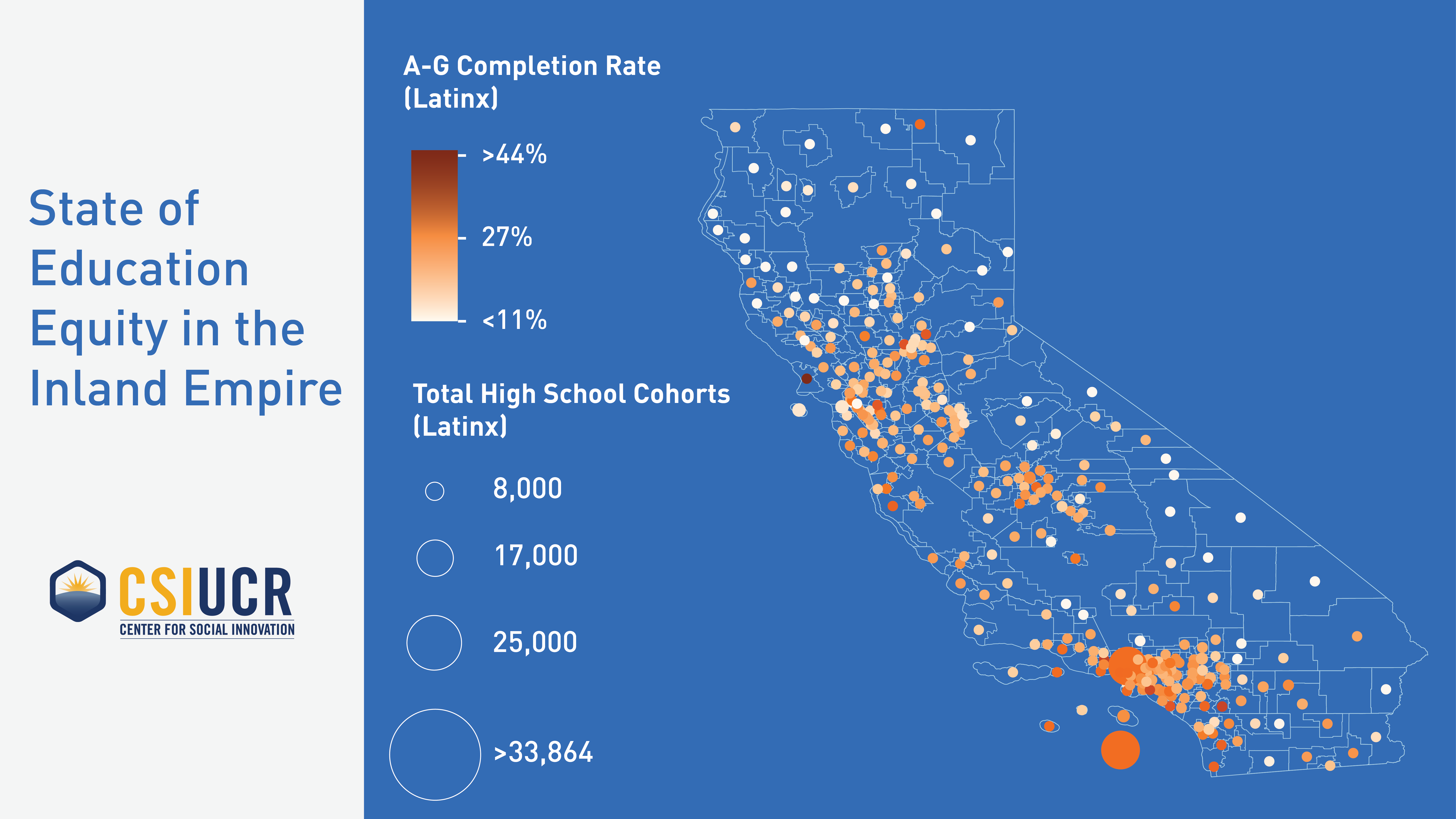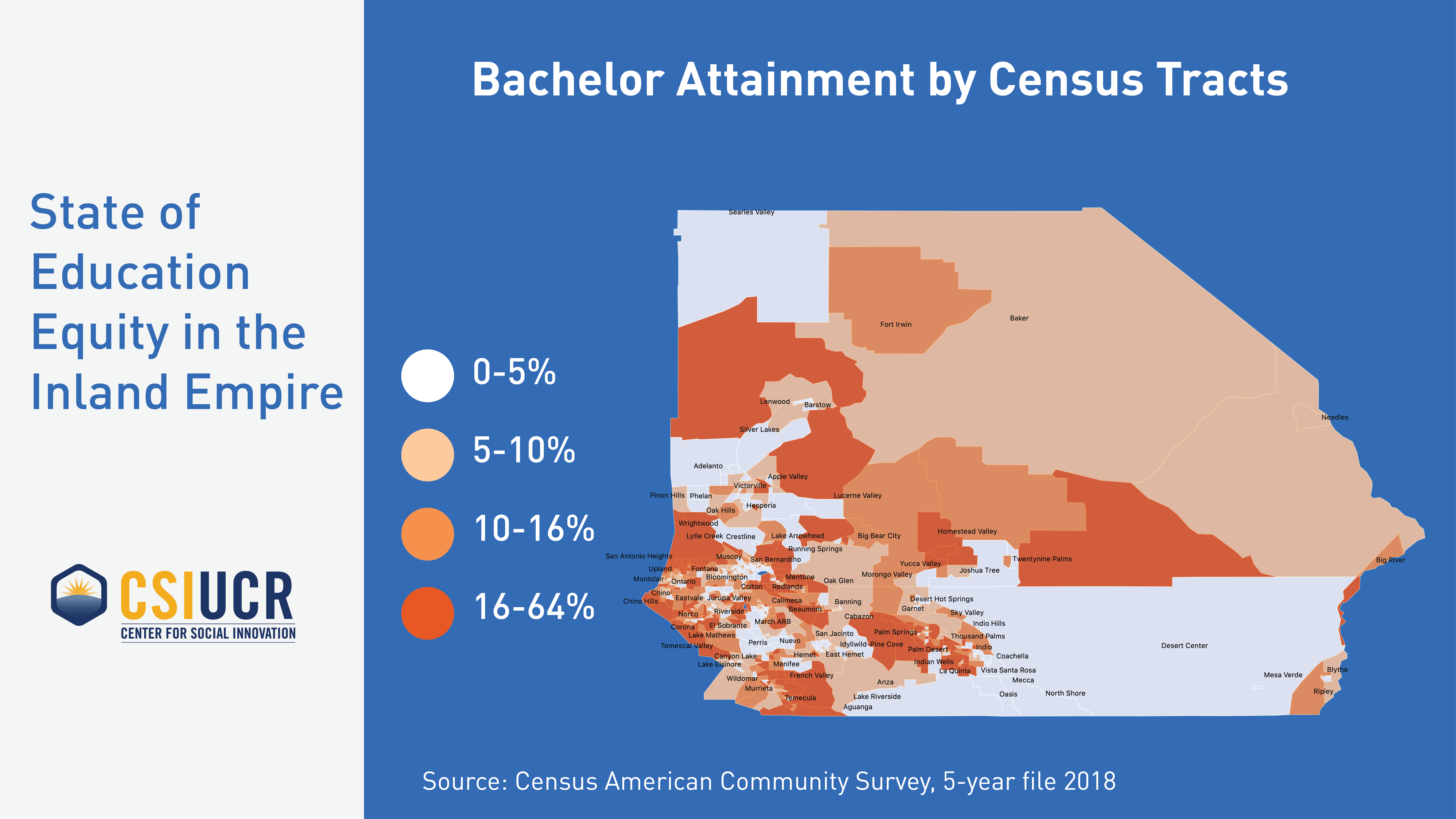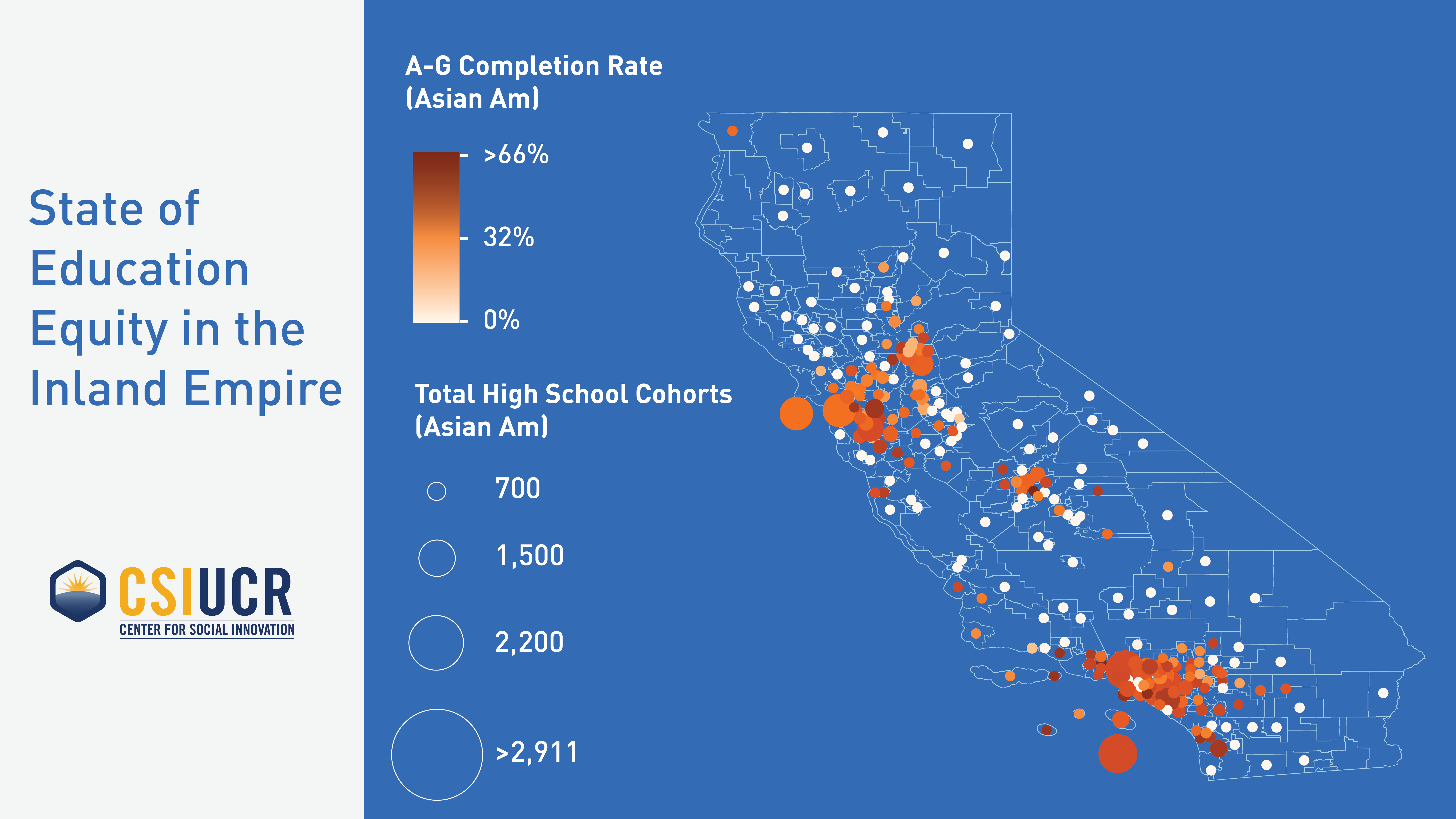Center for Social Innovation
State of Education Equity in the Inland Empire
Much like in the rest of the country, the historical legacies and contemporary manifestations of racial segregation and discrimination have led to deep inequities in educational attainment in the Inland Empire. Historically, the Inland Empire has been a place where indigenous education was delegitimized and anglicized, and where public education was marked by a high degree of racial segregation and disinvestment in communities of color.
At the same time, the Inland Empire has also been a place of community empowerment and progress. The region spawned great community leaders like Frances Grice who fought local busing laws all the way to the U.S. Supreme Court in 1973. The work of community engagement and empowerment to produce educational equity continues today, as is evident in the various nonprofit organizations we profile. Important, too, are the efforts of allies within government and educational systems, who are working in various ways to reform policies and practices that improve educational attainment, particularly among students of color.
This report highlights several important partnerships and collaboratives that are already underway, including those focused on “collective impact” involving leaders and administrators across educational and workforce systems. Fostering greater community engagement and influence in these efforts would ensure that these collective efforts move with greater urgency, and have greater impact.
Community Profiles
-
BLU Educational Foundation
Representative: Dina Walker & Rakayla Simpson
Position: President & CEO; College Prep Advisor, Public Policy and Advocacy Fellow
BLU Educational Foundation provides education and human services programming for youth, adults, and organizations to build healthy and productive communities. They focus on education, health, civic engagement, leadership, advocacy, and the arts. Based out of San Bernardino, much of their work centers on college access and working with high schools throughout the region.
President & CEO Dina Walker believes that investment in early childhood education across the region is lagging and that this especially affects low-income students of color. At all educational levels, Dina believes that utilizing more and better data is essential in reaching the students and families that are left behind. Dina advocates for using disaggregated data to have a better understanding of the gaps in which students are continuously being left behind, particularly in terms of gaps in race and gender. As Dina explains, “When you say that a program worked really well, but only for these people, you’re making a decision of who you’re not going to serve.”
Dina and Rakayla note that these disparities are growing even larger due to impacts from COVID-19. With the transition to distance learning and increased reliance on online platforms, BLU is advocating for more resources to address the needs of students. As Rakayla says, “We’re doing virtual college advising and many of the students don’t have a computer. So many people don’t have access to reliable internet on their computers or their phones.”
When asked about the future prospects of education equity in the region, Dina suggested that real systemic change is necessary.“If we’re really serious about making real changes we have to come to grips with the fact this system doesn’t work. It’s been 10, 20 years and we can still see these gaps in student achievement. We should be able to try something new, but we are too afraid to change the system” said Dina. She stated that “we can’t continue to invest in bad programs that are failing so many students.”
Despite these challenges, Dina and Rakayala did note the recent positive movement in community engagement and innovation in the region both with the Riverside County Office of Education and with San Bernardino City Unified.
-
Independent Educational Consultant
Representative: Dr. Talisa Sullivan
Position: Independent Educational Consultant
Dr. Talisa Sullivan is an independent educational consultant working in the region. When asked about education equity in the I.E., Dr. Sullivan noted that although there are examples of successful educational programs, she believes there is room for improvement at all levels of education. She believes that by providing resources to our most under-served communities, including training and workshops for parents and more educational support for students, education leaders can address some of these concerns. She also highlighted the need to ensure that our educational leaders look at equity from a holistic perspective rather than as a single metric to be met, “Equity is not a target or a check-mark, but more of a process and journey,” described Dr. Sullivan.
In the earlier grades, Dr. Sullivan described the unequal processes that result in labeling English Language Learners (ELL) and Black students as special needs, resulting in a lack of scaffolds that put them at a disadvantage once they reach middle school. As she described, “They have already fallen so far behind and we still have them in a system where they’re not thriving. We have to pay closer attention to students who have challenges in the primary grades and not focus on labeling them as having special needs, behavior problems, or being deficient.” This system follows students up through the secondary level where many students are no longer engaged and many instructors are not prepared to engage these students, described Dr. Sullivan.
Dr. Sullivan is passionate about the need for sustainable systems at all levels of education. This includes hiring teachers and education leaders with diverse experience and perspectives and similar backgrounds as the students they serve, as well as having staff that will be experts in cultural competency and would be able to provide ongoing training. As she described, “There are some best practices that you have visited before, but some best practices are important to revisit every week or every month in order to refine your skills and to hone in on that as a reminder that this is an important piece of ensuring that every kid gets what they need.”
Dr. Sullivan highlighted the strong collaboration across the two counties and across organizations throughout the Inland Empire. Many of these nonprofits and businesses are getting together to create equitable opportunities for students. Dr. Sullivan cited the increased awareness of inequities as well as a willingness to take action to address these inequities, as the catalyst for much of these recent gains.
-
Youth Mentoring Action Network (YMAN)
Representative: Dr. Torie Weiston-Serdan
Position: Co-Founder & Chief Visionary Officer
Youth Mentorship Action Network (YMAN) leverages the power of mentoring and the fight for equity and justice. Dr. Weiston-Serdan describes her organization’s work as supporting and resourcing young people so that they can do the work they need to do. YMAN’s work includes a hybrid one-to-one and group mentoring program which connects youth to elders that offer wisdom and support.
Dr. Weiston-Serdan noted, “I fell in love with mentoring because it was this idea that you can really connect for what could be a long-term relationship and it’s a different type of exchange than what is happening in schools.”
She continued, “A lot of what I’ve experienced in schools, it’s schooling. It’s just making sure that kids don’t get into trouble and making sure they have basic concepts for what we think the workforce needs. I don’t see a lot of innovation in schools. I’m not going to say that absolutely nothing is working. But I think that the antiquated model of what we call education just isn’t it.”
Dr. Weiston-Serdan believes that we need to rethink what education looks like, including re-imagining where education takes place. She stated,“I think until we take a fundamental look at education and our society and redefine it and figure out what it’s supposed to accomplish and for who I think it’s going to be a stagnant institution.” She suggested expanding learning sites to include community centers and giving young people more power about what they are learning. Instead of having businesses and places of employment dictating what education looks like, Dr. Weiston-Serdan suggested that schools take the lead and push the workforce to reflect what the youth envision for the next 10 years. She noted that this must be done with an equity lens, stating that “Investing in an education system that allows Black folks and brown folks and queer folks and poor folks to have a say in their education and freedom of imagination would really move the region toward equity.”
When asked about the promising work in the region on education equity, Dr. Weiston-Serdan pointed to organizations like BLU Educational Foundation, specifically their work surrounding community engagement. She believes that civic engagement advocacy is essential for addressing the issues of equity in education. As she described, the communities affected need to be empowered to take control and become decision makers that are in charge of their own destiny, not only in terms of education, but in all aspects of their lives as well.
-
Big Brothers Big Sisters of the Inland Empire
Representative: Jennifer O’Farrell
Position: Executive Director
Big Brothers Big Sisters of the Inland Empire is a social impact organization focused on providing youth mentorship and igniting youth potential. Through their programs, they aim to decrease the number of disconnected youth. Executive Director, Jennifer O’Farrell, noted that their 1-to-1 mentorship is a social emotional model designed to aid in personal growth and foster educational achievement and career success. As Jennifer stated, mentorship is necessary for marginalized youth of color to have an even playing field and is the key to expanding their access to resources through their mentor’s social capital.
In terms of bright spots in the region, Jennifer pointed to the increase in collaboration between higher education and K-12 institutions over the last 5 years. She suggests that the foundational building blocks for this collaboration are in place, but continued nurturing is needed to better serve the region’s students. Additionally, Jennifer praised the Inland Empire as a region of grit and resilience.
When asked about what areas need improvement in terms of education equity, Jennifer highlighted several areas that she saw, from the service provider perspective. Jennifer identified the need for new funding formulas to more equitably distribute resources, as she stated “zip codes should not define opportunity.” Additionally, she highlighted the need for more central coordination, on multiple levels. As Jenifer noted, central coordination can maximize and streamline resource services,which can ultimately transform neighborhoods and schools.
Similarly if there was centralized coordination, Jennifer was curious about shared data collection, response efforts towards shared data and results thanks to collective responses.
Jennifer also pointed out the need for more proactive student recruitment in pre-school and TK levels. As she stated, “research clearly demonstrates the effectiveness and advantage preschool education is. What if we recruited parents/guardians to enroll their preschooler rather than waiting for them to enroll?”
Jennifer also noted the strong and urgent need for a more holistic approach to education; one that serves the whole child, not just their academics. To achieve the goal of educational equity, not just in traditional academic indicators, but also in socioemotional, whole child learning, Jennifer believes these gaps will have to be addressed.
-
Campaign for College Opportunity
Representative: Sarah Mooney
Position: Regional Affairs Director
The Campaign for College Opportunity has focused on increasing college access and success for California students for over 16 years. The Campaign works toward ensuring that higher education programs are more efficient, more equitable, and more effective when it comes to access and success. The organization uses three main strategies to achieve their mission, including policy advocacy, research, and outreach.
Sara highlighted the energy around partnerships and collaboration in the Inland Empire and the dedication to understanding the role of racial justice in education. Although there are more nonprofits in the Los Angeles region compared with the Inland Empire, Sara believes that the incredible organizations working on multiple aspects of education are helping to build momentum in the region.
Sarah mentioned that although there have been educational successes throughout the IE in recent years, there remain areas that need to be addressed, including the lack of college counselors and A-G courses in high schools throughout the region. At the college and university levels, performance has not always been consistent and many local institutions remain impacted. “One consistent thread,” describes Sara, “is that all of the educational systems are failing Black students. This is important to address, particularly given how many Black residents got to the IE after getting displaced from Los Angeles.”
When asked about bright spots in the region, Sara highlighted the community-based work of Congregations Organized for Prophetic Engagement (COPE) that incorporates a faith-based, grassroots approach as well as cultivating strong relationships with policymakers. She also cited the work of BLU Educational Foundation for their transformative work in education, Promise Scholars based in Ontario for their comprehensive K-12 pipeline approach, and Growing Inland Achievement that has unified institutions in the region around data, best practices, and equity.
Sara underscores the diversity in residents as well as rural and urban areas throughout the region which are both a strength of the region and factors that can make it challenging for community-based organizations to reach all IE residents. “I hope that funders can come in to support the organizations that work with the residents and empower them with proper resources to actualize their own hopes for their communities. I’m hopeful that given the high need, folks with resources can be responsive to those needs,” said Sara. In particular, she pointed to a lack of resources for undocumented and Black residents in the area that need to be addressed.
-
Youth Action Project
Representative: Tremaine Mitchell
Position: Executive Director
Youth Action Project (YAP) provides youth and young adults with the opportunity to develop skills and habits to help them achieve social and economic success. With a focus on academic support and workforce preparation. YAP runs creative after school programs in San Bernardino Unified high schools and also provides support focused on math, English Language Arts, life skills, and social emotional skills that include services that support college and career pathways. “Today, issues of equity are at the forefront more than ever,” said Tremaine. She sees a genuine desire to address issues of equity, confront them, and provide better opportunities for students in the region. Tremaine acknowledged that young people have been the driving force for many of these changes, as she noted“Young people are no longer accepting the status quo.”
Tremaine pointed out that at all education levels, there are inequities for low-income and students of color as indicated by the data and additional supports are needed for students. For example, Tremaine noted that at the community college level, students can face many barriers including homelessness and the high cost of tuition, fees, and books.
Tremaine believes that the first step in developing investment strategies includes acknowledging that disparities exist as there is still resistance about supporting certain groups of students. Also, continued learning and unlearning need to happen to develop progressive policies. Another important step is engaging communities in the decision-making process, as Tremaine described.
Tremaine is hopeful about many programs and organizations that have been focusing on education in the IE. As she noted, “the work of IE RISE is bringing together many different stakeholders and is generating lots of excitement about the possibilities of the type of impact these collaborations can bring to the region.” Tremaine also flagged the great work of the Black Equity Initiative as a bright spot in the region.
Tremaine is optimistic, but realistic about the nature of educational equity work. As she described, “These issues are at the forefront at the moment, but lots of effort is needed to keep it that way in order to see it through to completion and create policies that are providing new support to students and families. As outside service providers, being part of that process and partnering with K-12 and college education systems are important to make sure that students are getting the access they need.”
-
Reach Out
Representative: Yara Williams
Position: Director of Health Workforce
As an intermediary organization, Reach Out follows a collective impact model and partners with K-12 schools, higher education, departments of public and behavioral health, and employers. Reach Out focuses on three main areas including youth and family wellness, community coalitions and healthy cities initiatives, and health workforce development. Dr. William’s focus on workforce development operates a youth drop-in center to provide a safe and supportive space for youth, and partnerships with schools to offer work-based learning opportunities. Much of her work focuses on health career pathway programs that allow students to expand their learning outside of classrooms through job shadows, internships, and site visits.
When asked about what is working well in the region in terms of education, Dr. Williams highlighted the collaboration between various education, nonprofit, and business leaders in the region. She also highlighted the investments from local businesses to engage youth and education stakeholders that have been willing to be responsive to the needs of our employers, whether that means more soft skills training for students or opportunities for certain certifications.
Dr. Williams called attention to the need for more pathways to the workforce and colleges beginning in elementary and middle schools. As Dr. Williams describes, at the college level there has been a shortage of clinical sites for students earning degrees to receive their training. The limited seats for students is exacerbated by the current healthcare workforce shortage, she noted.
Dr. Williams underscored the need to continue to focus on diversifying our workforce. “We really try to ensure that students have equitable opportunities to explore the field and gain those experiences. However, challenges to reaching students in remote parts of the region and calls for more funding to ensure all students have those same opportunities to get the education and training to earn a living wage. “ she stated.
Additionally, Dr. Williams pointed out the shift toward apprenticeship programs. Although some programs are already well-developed in certain industries, she hopes they will grow in the healthcare field as well. As she stated, “That is what needs to grow, it’s the future of workforce.”
-
Clay Counseling Solutions
Representative: Dr. April Clay
Position: CEO
Clay Counseling Solutions provides culturally competent counseling services to schools, families and individuals throughout the Inland Empire. CEO, Dr. April Clay, noted they do this through a variety of ways including school-based services including restorative circles, staff training, classes for parents, groups, workshops and assemblies.
Dr. Clay also reiterated the importance of providing evidence-based counseling services. CCS understands that student well-being is not just about physical health, but mental health needs, including the effects of racial discrimination. Dr. Clay also noted their particular focus on restorative based services.
The population CCS serves are dealing with a lot of trauma. There is a lack of behavioral support in the school system and children could be misdiagnosed with conditions like ADHD because of cultural misunderstandings. Dr. Clay mentioned that they provide homeless services as well.
Dr. Clay noted that although COVID-19 has had an immense negative impact on the Inland Empire, an unintended benefit has been that school districts are now forced to address the tech divide, especially in terms of remote learning. While it has been a challenge, Dr. Clay cited that local leaders and community partners are taking charge and working more closely together around these issues. COVID-19 has created the space for educational innovation.
When asked about what is not working well in the region, Dr. Clay flagged the communication between school and home as a huge concern. She noted that the relationships between parents and schools needs to be built up more. There should be specific efforts to get parents more involved.
Another issue flagged by Dr. Clay was the need for cultural competency in schools. She noted that oftentimes the institution of education will look down on diversity. For example, different ways of thinking and diverse languages like “Black English” and “Spanglish”.
Dr. Clay mentioned that despite these challenges, her outlook for the future of our region is positive. She cites an increase in collaboration across different sectors and an increase around conversations about equity in education. Dr. Clay stated that she would love to see schools become true centers of community. They should be the foundation of the community, not only for children, but to encourage and facilitate community growth and togetherness.
-
Alianza
Representative: Patricia S. Carrillo
Position: Project Manager
Alianza is a nonprofit organization based in the Eastern Coachella Valley. The organization’s mission is to transform the socioeconomic conditions of the Coachella Valley using the collective impact model and guided by diversity, equity, and inclusion. Alianza works on multiple programs and campaigns, including the environmental justice campaign which focuses on air and water quality and pushes for investment and policy change. The community justice campaign is advocating for the implementation of restorative justice protocols, accountability on their local control funding, and providing training and tools for staff and students to have stronger relationships leading to student empowerment. Finally, the Youth Organizing Council supports local youth leadership development and community engagement.
Program Manager, Patricia, highlighted the strong representation and diversity of school teachers, staff, and administrators in the region. “Many of our staff members grew up in the area, they’re able to have that connection with the students,” said Patricia. She also emphasized that Coachella area schools are offering many more resources to students, including extracurricular activities, field trips, and college exploration programs.
Patricia believes that there continues to be a need for restorative justice practices at all levels of education as well as the need for more equitable funding for students across the board, including English Language Learners (ELL) and foster students. Patricia expressed the need for more resources to be allocated to mental and socio-emotional health, as well as lower counselor-to-student ratios and the removal of school resource officers from campuses, “We need to be focused on equitable funding for student resources and not use so many school resources for security.” Patricia also believes that all stakeholders should be represented and at the table for key decision-making processes.
Patricia has a hopeful outlook for the future of education equity in the region. She envisions a community in which all stakeholders have a seat at the table at all levels of government. She hopes to continue to see residents feel empowered to make changes in their own communities and an educational system with full transparency. As Patricia expressed, “Changing even one person’s life can have a domino effect.”
-
Congregations Organized for Prophetic Engagement (COPE)
Representative: Felicia Jones, Jewel Patterson
Position: Associate Director, Youth Organizer
The mission of COPE is to build the capacity of clergy community members, including students, parents, and grassroots leaders to revitalize the communities where they live, work, and worship. They focus on the intersection of education, healthy, criminal justice, and now housing with a strong focus on education equity as a deterrent to mass incarceration.
Jewel described the IE as a place with strong relationships between nonprofits, elected officials, and community members, “Leaders are dedicated to education equity, they’re willing to go an extra mile for the partners they’ve forged through relationships and collaborations,” said Jewel. Felicia echoed the sentiment and added that systems leaders have been very accessible to the community. Additionally, restorative justice practices have been implemented successfully in some elementary schools in the region. Both Felicia and Jewel highlighted the disproportionate underachievement for students of color and the work that needs to be done to address the instructional needs of students with cultural competency at all levels. A key area of concern includes the history of funneling students through the school-to-prison pipeline. “We have spent more on policing them than providing access to student support to address their academic challenges and preparing them for college,” said Felicia.
Felicia and Jewel noted that students need support inside and outside the classroom. They believe that more investment in counselors for both academic and social emotional support, investments in academic support in the classroom including aides, and more extracurricular activities and outside engagement to keep students connected to the learning process are all crucial. “Investing in after school and in-school clubs are important so that students can feel a part of something,” said Jewel.
When asked about bright spots in the region, they pointed to San Bernardino’s district-wide Equity and Targeted Student Achievement Department, which is charged with addressing academic equity needs of students of color. The department also launched an African American Student Learners Initiative that includes a pilot teacher development program, and seeks to achieve parity in programs with low African-American student representation, and creating a platform for African American parents.
For both Felicia and Jewel, education equity in the IE rests on engaging and empowering students in their own education. As Jewel described, “Students are ready for this, the current climate has created the conditions to push the envelope for education equity in schools.”
-
Autism Society Inland Empire
Representative: Beth Burt
Position: Executive Director, Autism Society Inland Empire
Autism Society Inland Empire is the local chapter of the Autism Society of America. This grassroots organization aims to improve the lives of all who are affected by autism, as explained by Executive Director Beth Burt. According to recent survey data, there are more than 15,000 individuals with autism in the Inland Empire and another 60,000 family members of those individuals. Autism Society Inland Empire works to empower those individuals and families through education, workforce development, resource support, social opportunities, and much more.
The impact of the COVID-19 pandemic has been particularly hard on those with disabilities, as Beth noted. Beyond the increased risk of contracting COVID-19, those with autism and other intellectual disabilities are facing an uphill battle in terms of the recent impacts to the education system. According to data from the Autism Society of California, 1 in 4 students with disabilities will not wear a mask for an extended period of time, and 1 in 3 do not understand the concept of social distancing. Additionally, many medical therapies have gone remote or have stopped all together. As Beth described these therapies work in tandem together with education. Furthermore, those with autism are seeing their routines completely changed, which can be particularly upsetting and has led to an increase in aggressive behaviors.
Beth did state that before COVID-19 the school districts in the Inland Empire had done a good job of reaching out to special education parents, but due to the recent strains in the education system the communication has not been as consistent.
When asked about what future investments are needed, Beth cited that beyond the immediate equity needs surrounding the pandemic, schools need to better prepare special education students for employment and independence. She cited that those with autism and other developmental disabilities have about a 96 percent unemployment rate in California. Often, Beth described, that these children will age out of workforce programs and are not able to get to the next step of actual employment. Beth also mentioned the importance of the diversity of skills and needs of those with autism and developmental disabilities. Beth believes that there cannot be a one size fits all solution, there needs to be an individually tailored holistic approach to educating students with disabilities for the workforce.
-
American Civil Liberties Union of Southern California
Representative: Victor Leung
Position: Deputy Litigation Director/Senior Staff Attorney
The ACLU works in courts, legislatures, and communities to protect constitutional and civil rights on behalf of people of color and other underserved groups. Their work spans multiple areas, including a robust education equity program that aims to ensure that all students have access to the highest quality education. Although the ACLU has been serving the entire Southern California region for decades, they opened up an Inland Empire-specific office in San Bernardino in 2014 with a focus on education, among other issues.
Victor touted the strong community-based organizations in the Inland Empire. “There are many organizations that are doing excellent work in the community, but they run up against challenging school districts,” said Victor.
Victor believes that although there have been significant gains in educational equity in the region, the ACLU has focused on school funding issues, including ensuring that the counties and school districts implement the Local Control Funding Formulas (LCFF) equitably and transparently. Recently, the ACLU, in partnership with local community-based organizations, has been at the forefront of a recent complaint which alleges that the San Bernardino County Office of Education violated their obligations under the LCFF, resulting in millions of dollars that were earmarked for high-needs students of color being misspent.
Victor stressed the need for the culture of schools to change. “There are a lot of good people doing some amazing work, but they’re not in positions of leadership. We need to empower communities more and address the disconnect between schools and families,” said Victor. He also believes that our schools need to be decriminalized and that districts should spend money on students instead of law enforcement or school hardening measures. Victor also noted that students with disabilities are underserved statewide and districts do not have enough resources to provide the services they need.
There are many community-based organizations, parent organizations, and faith-based organizations in the region that have been working on educational equity “The culture is shifting slowly,” said Victor, “there are more opportunities for community-based organizations to engage in effective campaigns.” Despite the trauma stemming from criminalization and racism in the education system and the effects of the pandemic, Victor remains optimistic for the future of education in the region.
-
Growing Inland Achievement
Representative: Ann Marie Sakrekoff
Position: Senior Director
Growing Inland Achievement is a regional, collective impact organization that focuses on educational and economic equity. Founded in 2015 through a Governor’s Innovation grant, GIA connects organizations and serves as the intermediary for institutions. Senior Director Ann Marie Sakrekoff describes the work of GIA as inter-segmental, including working across segments of education and making connections with civic and business sectors as well as nonprofits to create systems change. “There are systems that were created long ago that are broken and not serving our students or institutions. It is our job to help institutions identify those systems,” says Ann Marie.
Ann Marie believes that the high levels of collaboration between institutions and organizations across the region are one of the strengths of the IE. She believes that much of the success in the region can be attributed to data-driven policies. One of the catalysts of educational success are the leaders who are taking the initiative surrounding conversations around equity, which helps to facilitate action on areas of injustice.
Ann Marie believes that students need more support in the transitional spaces between educational segments, particularly from high school to post-secondary education and transferring from a two-year institution to a four-year institution. “There is a lot of work that needs to happen where students may graduate or be ready to transfer but the support is not there. The rates are not where they need to be in order for the region to have a robust economy and unfortunately it is lower for our marginalized students. We need to have targeted support for our students who are struggling, and for Black students in particular.” She underscores the need for comprehensive data to better understand these gaps in student education.
Additional support is also needed for our returning adult students in our region. Ann Marie believes we need to identify the reasons that students may have left school and what we can do to support them. Reforms such as creating a cohort model of adult education, or taking one class at a time on a consistent schedule could make a large-scale impact for our region, say Ann Marie.
Ann Marie believes that we need to engage our students and families more in these conversations and the decision-making processes. We also need to have more student involvement and to pay them for their time. Finally, we need more basic needs support and technology support. As she notes, “I’m excited about the opportunities that I’ve seen on the horizon, but I also recognize and that it will take a lot of hard work and building relationships with each other. We need to build community as we continue this work.”
